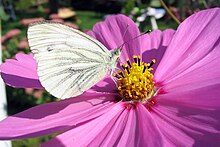Green-veined white
| Green-veined White | |
|---|---|

| |
| Scientific classification | |
| Kingdom: | |
| Phylum: | |
| Class: | |
| Order: | |
| Superfamily: | |
| Family: | |
| Subfamily: | |
| Tribe: | |
| Genus: | |
| Species: | P. napi
|
| Binomial name | |
| Pieris napi (Linnaeus, 1758)
| |
The Green-veined White (Pieris napi) is a butterfly of the Pieridae family.
Appearance, behaviour and distribution
Widespread across Europe, Asia including the Indian subcontinent and North America, it is found in meadows, hedgerows and woodland glades but not as often in gardens and parks like its close relatives the Large and Small Whites, for which it is often mistaken. Like other "white" butterflies, the sexes differ. The female has two spots on each forewing, the male only one. The veins on wings of the female are usually more heavily marked. The underside hindwings are pale yellow with the veins highlighted by black scales giving a greenish tint, hence Green-veined White! Unlike these two butterflies it rarely chooses garden cabbages to lay its eggs on, preferring wild crucifers.
Life cycle and foodplants

The eggs are laid singularly on a wide range of foodplants including Hedge mustard Sisybrium officinale Garlic Mustard Alliaria petiolata, Cuckooflower Cardamine pratense, Water-cress Rorippa nastutium-aquaticum, Charlock Sinapis arvensis, Large bitter-cress Cardamine amara, wild cabbage Brassica oleracea and wild Radish Raphanus raphanistrum and so it is rarely a pest in gardens. The caterpillar is green and well camouflaged. It is often found feeding on the same plant as the Orange Tip but never competes for food because it only feeds on the leaves whereas the Orange Tip caterpillar feeds on the flowers and developing seed pods. Like other Pieris spp. it overwinters as a pupa. It can produce up to three broods in a year.
Recent research has shown that when males mate with a female, they inject methyl salicylate along with their sperm. The smell of this compound repels other males, thus ensuring the first male's paternity of the eggs—a form of chemical mate guarding.
The adult male of this species has a distinctive lemon smell.

References
- Jim Asher et al The Millennium Atlas of Butterflies of Britain and Ireland Oxford university Press
